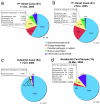Impacts of Hurricanes Katrina and Rita on the microbial landscape of the New Orleans area
- PMID: 17488814
- PMCID: PMC1885622
- DOI: 10.1073/pnas.0610552104
Impacts of Hurricanes Katrina and Rita on the microbial landscape of the New Orleans area
Abstract
Floodwaters in New Orleans from Hurricanes Katrina and Rita were observed to contain high levels of fecal indicator bacteria and microbial pathogens, generating concern about long-term impacts of these floodwaters on the sediment and water quality of the New Orleans area and Lake Pontchartrain. We show here that fecal indicator microbe concentrations in offshore waters from Lake Pontchartrain returned to prehurricane concentrations within 2 months of the flooding induced by these hurricanes. Vibrio and Legionella species within the lake were more abundant in samples collected shortly after the floodwaters had receded compared with samples taken within the subsequent 3 months; no evidence of a long-term hurricane-induced algal bloom was observed. Giardia and Cryptosporidium were detected in canal waters. Elevated levels of fecal indicator bacteria observed in sediment could not be solely attributed to impacts from floodwaters, as both flooded and nonflooded areas exhibited elevated levels of fecal indicator bacteria. Evidence from measurements of Bifidobacterium and bacterial diversity analysis suggest that the fecal indicator bacteria observed in the sediment were from human fecal sources. Epidemiologic studies are highly recommended to evaluate the human health effects of the sediments deposited by the floodwaters.
Conflict of interest statement
The authors declare no conflict of interest.
Figures






Comment in
-
Après le déluge: microbial landscape of New Orleans after the hurricanes.Proc Natl Acad Sci U S A. 2007 May 29;104(22):9103-4. doi: 10.1073/pnas.0703191104. Epub 2007 May 22. Proc Natl Acad Sci U S A. 2007. PMID: 17519330 Free PMC article. No abstract available.
References
-
- Presley SM, Rainwater TR, Austin GP, Platt SG, Zak JC, Cobb GP, Marsland EJ, Tian K, Zhang B, Anderson TA, et al. Environ Sci Technol. 2006;40:468–474. - PubMed
-
- Stoeckel DM, Bushon RN, Demcheck DK, Skrobialowski SC, Kephart CM, Bertke EE, Mailot BE, Mize SV, Fendick RB., Jr . Bacteriological Water Quality in Lake Pontchartrain Basin LA, Following Hurricanes Katrina and Rita, Sep. 2005. Reston, VA: US Geol Surv; 2005. (Data Series 143).
-
- Hou A, Laws EA, Gambrell RP, Bae H-S, Tan M., DeLaune RD, Li Y, Roberts H. Environ Sci Technol. 2006;40:5904–5910. - PubMed
-
- Pardue JH, Moe WM, Mcinnis D, Thibodeaux LJ, Valsaraj KT, Maciasz E, Van Heerden I, Korevec N, Yuan QZ. Environ Sci Technol. 2005;39:8591–8599. - PubMed
-
- Centers for Disease Control and Prevention. Morbid Mortal Wkly Rep. 2005;54:928–931. - PubMed
Publication types
MeSH terms
Grants and funding
LinkOut - more resources
Full Text Sources
Other Literature Sources
Medical
Molecular Biology Databases

